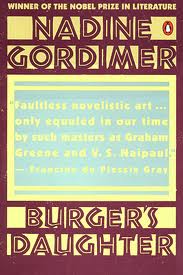Resource Title
Burger’s Daughter
Summary
Set in South Africa during the apartheid regime, this novel is about the beginning of a young white woman’s political consciousness.
Resource Details
Description
Nadine Gordimer is a leading South African writer who became a symbol of free speech for her work documenting the brutal consequences of apartheid in the lives of ordinary people, sometimes defying censorship to do so. In the 60’s and 70’s she was often at the forefront of protests and was part of the underground movement that helped the African National Congress (ANC). Three of her novels were banned in her own country.
Gordimer was born in 1923, outside Johannesburg, to a British mother and a Jewish Lithuanian father. An ardent reader from a young age, she began publishing short stories at the age of 15. She became aware of the harsh unfairness of the apartheid system early in her life when she used to devour books from her local library but realised that black people could not even enter the place.
Nelson Mandela read her 1979 novel Burger’s Daughter in jail on Robben Island and she was one of the first people invited to visit him on his release. She has written 14 novels, which have been published in forty languages as well as non-fiction, plays, essays and nineteen short story collections.
Gordimer has turned her focus to writing about the complexities of the new post-apartheid South Africa such as the AIDS epidemic, the continuing poverty and increasing crime in the country. She was the joint winner of the Booker Prize in 1974 for her novel “Conservationist” and was awarded the Nobel Prize for Literature in 1991 – the year South Africa repealed its apartheid laws. Among her most well-known novels are The Conservationist (1974); Burger’s Daughter (1979); July’s People (1981); My Son’s Story (1990), The House Gun (1997); and The Pickup (2001).
Available from:
Burger’s Daughter on Google Books.

